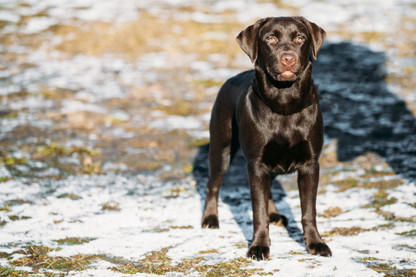01/24/2024
How can I help my dog with Elbow Dysplasia?
Elbow dysplasia is a painful condition that affects dogs, typically showing up in puppies between 5 and 14 months old. It’s more common in medium-to-large breeds and is often inherited. This condition involves abnormal growth in one or both elbow joints. Let's explore what causes elbow dysplasia, how it’s treated, and what to expect after treatment.
Components of Elbow Dysplasia
- Ununited Anconeal Process (UAP): This occurs when a part of the elbow joint doesn't properly fuse with the ulna during growth.
- Fragmented Coronoid Process (FCP): This happens when a piece of the ulna’s coronoid process breaks off, usually in larger breeds. Surgery is often needed to remove the fragment and stabilize the joint.
- Osteochondritis Dissecans (OCD): Involves defects and loose fragments of cartilage in the elbow joint, commonly seen in young, growing dogs. Surgery is typically required to remove the affected cartilage.
- Elbow Incongruity: Occurs when the two main bones of the forearm (radius and ulna) grow at different rates, requiring surgery for better alignment.
Each of these issues can cause joint instability, inflammation, pain, and lameness. If left untreated, they can progress to arthritis.
Genetic Factors
Genetics play a significant role in elbow dysplasia. Puppies within the same litter can develop the condition as they grow. Environmental factors like diet and exercise levels also influence the likelihood of developing elbow dysplasia.
Breeds at Higher Risk
Some breeds are more prone to elbow dysplasia, including:
- Basset Hound
- Bernese Mountain Dog
- German Shepherd
- Great Dane
- Newfoundland
- Labrador Retriever
- Rottweiler
- Golden Retriever
Symptoms of Elbow Dysplasia
Symptoms can start when your dog is just a puppy. You might notice stiffness in the front legs, causing limping, especially after exercise. This can persist even after rest. Cold or damp weather might make the discomfort worse, and your dog may seem more sluggish.
Over time, symptoms can worsen, leading to swelling and puffiness in the elbows. Your dog might also show outward-pointing elbows and front feet. The pain often reduces their enthusiasm for activities like playing or walking, and can lead to arthritis. Mobility issues and a crunching noise in the elbow joints might become apparent, eventually causing noticeable lameness.
Treatment for Elbow Dysplasia
There is no cure for elbow dysplasia, but proper diagnosis and care can improve your dog’s quality of life.
- Veterinary Visit: If you notice symptoms, visit the vet for a physical exam and radiographs of the elbow joints. In complex cases, the images may be sent to a Veterinary Radiologist or a Veterinary Surgeon for consultation.
- Surgery: In moderate to severe cases, surgery may be necessary. Procedures might include:
- Removing loose fragments or cartilage
- Changing the elbow joint to alleviate pressure on the damaged part
- Reattaching or removing the UAP
- Correcting the joint alignment
- Joint replacement
- Pain Management: For older dogs or less severe cases, pain management is crucial. This can involve:
- Elbow Bracing: Try our Full Length Adjustable DogLeggs for added support.
- Weight Control: Maintaining a healthy weight to avoid extra pressure on joints.
- Exercise: Regular, short walks to keep your dog fit without overexertion.
- Medication: Anti-inflammatory drugs to manage pain.
- Rest: Ensuring proper rest, especially after exercise.
- Complementary Therapies: Treatments like acupuncture, chiropractic care, hydrotherapy, and therapeutic ultrasound can help manage pain and improve mobility.
Conclusion
Since there is no cure for elbow dysplasia, lifelong treatment and pain management are necessary. Early diagnosis and treatment are essential for improving your dog’s quality of life. If you have concerns about your dog’s joint health, consult your veterinarian.
For more information about how we can help, contact us at DogLegg. We're here to support you and your furry friend.

